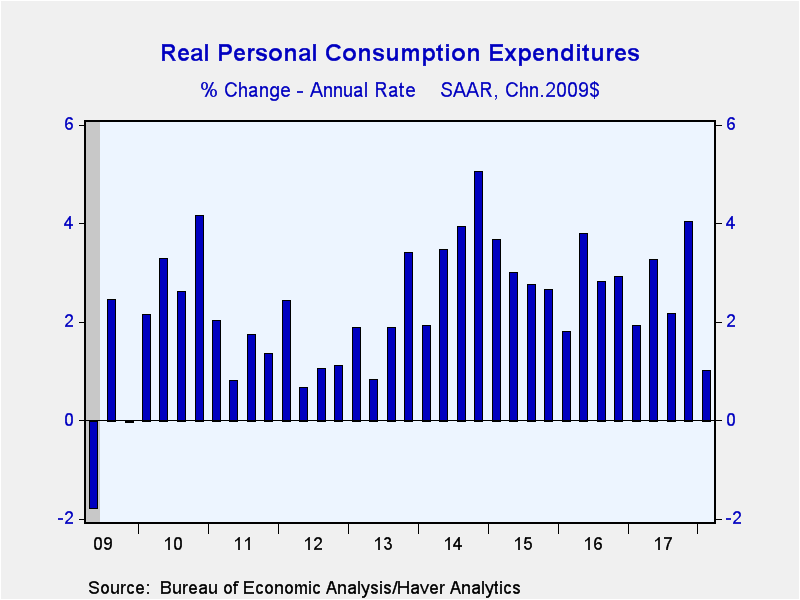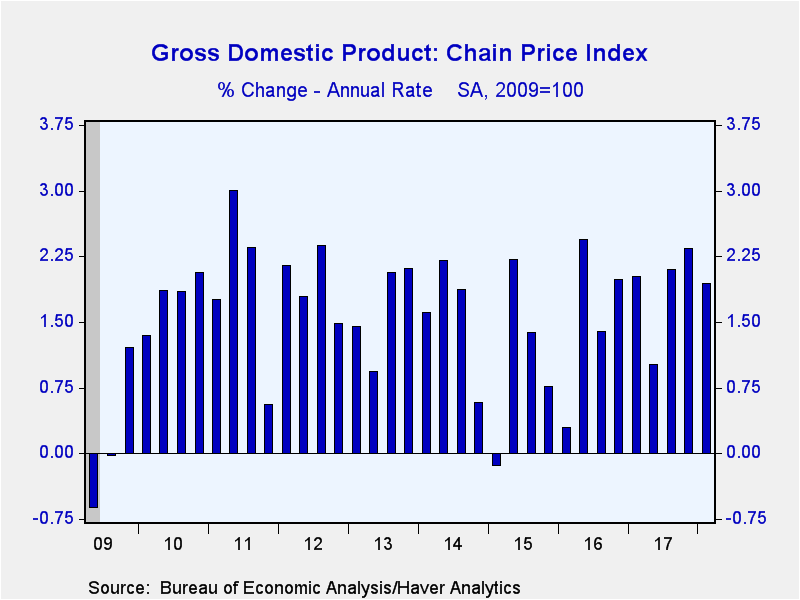 Global| May 30 2018
Global| May 30 2018U.S. GDP Growth Revised Down; Corporate Profits Rebound
by:Tom Moeller
|in:Economy in Brief
Summary
U.S. economic growth slowed a bit more than initially estimated in Q1'18. Real gross domestic product grew at a 2.2% annual rate, revised from 2.3% estimated initially. The rise followed 2.9% growth during Q4'17. A 2.3% increase had [...]
U.S. economic growth slowed a bit more than initially estimated in Q1'18. Real gross domestic product grew at a 2.2% annual rate, revised from 2.3% estimated initially. The rise followed 2.9% growth during Q4'17. A 2.3% increase had been expected in the Action Economics Forecast Survey. It remained the weakest rate of growth in four quarters. Domestic final demand growth was revised higher to 1.9% (2.8% y/y) from 1.6%, and followed a 4.5% gain in Q4'17. Growth in the GDP price index was revised to 1.9% (1.8% y/y) from 2.0%.
After-tax corporate profits without inventory valuation and capital consumption adjustments increased 7.8% (0.1% y/y) following a 9.6% decline. Volatility may have been exaggerated by significant tax law changes. Pretax profits with IVA & CCA eased 0.6% (+4.3% y/y) after a 0.1% slip. Nonfinancial corporate earnings declined 1.5% (+5.8% y/y) after 1.5% rise. Earnings in the financial sector improved 0.5% after a 3.0% decline. Profits earned abroad increased 1.0% following a 1.3% fall.
A lessened contribution to GDP growth from inventories accounted for the downward revision to GDP growth. It was revised to 0.1 percentage points from 0.4 percentage points estimated initially. The effect on growth from foreign trade also was reduced slightly to 0.1 percentage points. Exports grew 4.2% both q/q and y/y after a 7.0% Q4'17 gain while imports rose 2.8% (4.3% y/y) following a 14.1% jump.
 Business fixed investment growth was revised higher to 9.2%
(6.8% y/y) from 6.1%. Spending growth on equipment was revised to 5.5% (9.1%
y/y) from 4.7% as growth in spending on intellectual
property products was revised to 10.9% (5.1% y/y) from 3.6%. These advances compared to 3.9%
during all of last year and 6.3% in 2016. Information
processing equipment spending growth also was raised to 11.1% (10.3% y/y) from 9.7% (9.9% y/y).
Transportation equipment growth slowed to 3.9% (8.7% y/y)
following two quarters of roughly 15.0% gain. Investment in industrial
equipment grew an upwardly revised 6.5% (7.5% y/y). Investment in structures
increased 14.3% (4.9% y/y) after a 6.3% rise.
Business fixed investment growth was revised higher to 9.2%
(6.8% y/y) from 6.1%. Spending growth on equipment was revised to 5.5% (9.1%
y/y) from 4.7% as growth in spending on intellectual
property products was revised to 10.9% (5.1% y/y) from 3.6%. These advances compared to 3.9%
during all of last year and 6.3% in 2016. Information
processing equipment spending growth also was raised to 11.1% (10.3% y/y) from 9.7% (9.9% y/y).
Transportation equipment growth slowed to 3.9% (8.7% y/y)
following two quarters of roughly 15.0% gain. Investment in industrial
equipment grew an upwardly revised 6.5% (7.5% y/y). Investment in structures
increased 14.3% (4.9% y/y) after a 6.3% rise.
Consumer spending growth was little changed at 1.0% (2.6% y/y) after a 4.0% rise. It was the slowest growth since the second quarter of 2013. Spending restraint was notable in the durable goods sector where purchases declined 2.6% (+6.7% y/y) after a 13.7% Q4 surge. Motor vehicle & parts buying pulled back 11.4% (+4.5% y/y) on the heels of two straight quarters of double-digit growth. Growth in home furnishings buying of 2.3% (8.3% y/y) followed a 13.1% Q4 surge. Recreation goods & vehicle purchases grew a lessened 1.8% (7.0% y/y) after a 12.8% rise. In the nondurable goods sector, spending nearly came to a standstill. The little-changed 0.4% uptick (2.9% y/y) followed 4.8% growth in Q4. The pullback was led by an 8.1% decline (+2.7% y/y) in apparel outlays following a 10.6% spurt at yearend. Gasoline & fuel oil spending also fell 3.7% (+0.5% y/y) after a 0.1% increase. Food & beverage outlays grew 1.0% (2.8% y/y) following a 6.8% rise. Service sector spending growth was little changed and fairly steady at 1.8% (1.9% y/y). Transportation outlays grew 3.2% (1.6% y/y) after a 4.7% improvement. Health care purchases increased 1.2% (2.4% y/y) following a 2.5% advance and spending on recreation improved 0.7% (0.4% y/y) following a 0.9% decline. Housing utilities rose just 0.2% (1.4% y/y) following a 2.1% gain.
Offsetting the upward revision to business investment growth was a decline in residential building sector activity. It fell at a 2.0% rate (-4.7% y/y), revised from 0.1%, after a 12.8% rise in Q4.
Government sector spending grew at a slightly revised 1.1% rate both q/q and y/y after a 3.0% rise. Federal government spending improved 1.7% (2.0% y/y) following a 3.2% increase. Slower growth in defense spending of 1.8% (3.6% y/y) followed a 5.5% increase. This gain was accompanied by a pickup in nondefense outlay growth to 1.6% (-0.2% y/y) from -0.1% in Q4. State & local government purchases grew 0.8% (0.6% y/y) following a 2.9% increase.
The GDP price index increased a little-changed 1.9% (1.8% y/y) following a 2.3% gain. Nevertheless, these growth rates were the quickest in six years. The PCE price index increased 2.6% (1.8% y/y), about as it did in Q4 and greatly elevated from early last year. These were the quickest growth rates in the price index since 2011. The acceleration reflected faster consumer services price growth of 2.8% (2.5% y/y) which offset a 1.7% decline (-2.5% y/y) in prices for consumer durable goods. Nondurable consumer goods prices rose 3.9% (1.6% y/y). Growth in the business fixed investment price index accelerated to 1.2% y/y, double the growth in 2015. Residential fixed investment prices grew an upwardly revised 5.1% y/y, up from 2.7% in 2015. The government sector price index rose a steady 3.2% (2.5% y/y).
The GDP figures can be found in Haver's USECON and USNA database. USNA contains virtually all of the Bureau of Economic Analysis' detail in the national accounts, including the integrated economic accounts and the recently added GDP data for U.S. Territories. The Action Economics consensus estimates can be found in AS1REPNA.
Less Food & Energy
Tom Moeller
AuthorMore in Author Profile »Prior to joining Haver Analytics in 2000, Mr. Moeller worked as the Economist at Chancellor Capital Management from 1985 to 1999. There, he developed comprehensive economic forecasts and interpreted economic data for equity and fixed income portfolio managers. Also at Chancellor, Mr. Moeller worked as an equity analyst and was responsible for researching and rating companies in the economically sensitive automobile and housing industries for investment in Chancellor’s equity portfolio. Prior to joining Chancellor, Mr. Moeller was an Economist at Citibank from 1979 to 1984. He also analyzed pricing behavior in the metals industry for the Council on Wage and Price Stability in Washington, D.C. In 1999, Mr. Moeller received the award for most accurate forecast from the Forecasters' Club of New York. From 1990 to 1992 he was President of the New York Association for Business Economists. Mr. Moeller earned an M.B.A. in Finance from Fordham University, where he graduated in 1987. He holds a Bachelor of Arts in Economics from George Washington University.












